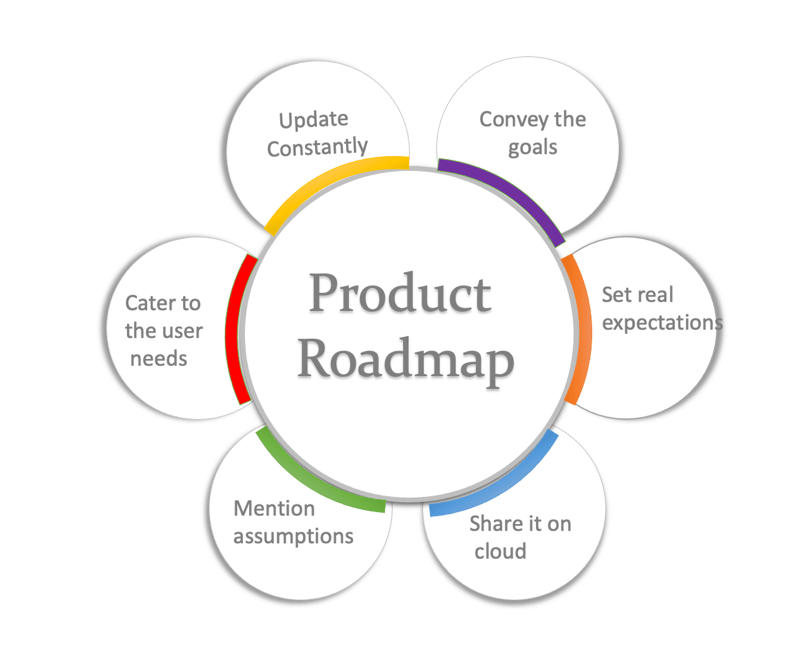A product roadmap is a strategic document to accomplish tasks vital for the success of any product. A product roadmap is not merely a roadmap of your product features to be released in a time period but also outlines the direction and vision of your product over time. A roadmap is a living document that guides the execution of the product strategy.
When created in the right way, a product roadmap can help in achieving multiple goals. It helps to:
- Bring key stakeholders on one page.
- Create a common understanding of product strategy and vision.
- Keep everyone focused on the priorities by acting as a source of truth.
A product roadmap can achieve all these goals only if a product manager prepares it with the necessary details without falling into common pitfalls.
As a product manager when you put so much effort into creating a product roadmap, seeing it fail due to common mistakes can be heartbreaking. Let’s go through the common pitfalls which you can avoid while creating a product roadmap to ensure it is going to serve the intended purpose.
Not updating the product roadmap
Let’s say as a product manager you have worked with different stakeholders and come up with a product plan which is in alignment with the KPIs and all the key stakeholders. Once the team starts building the features and starts executing the steps as per the roadmap, sometimes the teams get engaged so much into the nitty-gritties of the features being built that they tend to forget about the big picture. A Product Roadmap is one source of truth that needs to be referenced at any point if the team or anyone involved has questions.
To make sure that the product roadmap can serve this purpose and is reliable enough to guide everyone towards the right path, it is a must to keep this document updated with time. Sometimes even after the roadmap has been communicated and prepared, there could be changes in the market, consumer demands, or changes to company goals. It is, therefore, crucial to review the product roadmap every week or as per your cadence of stakeholder meetings. You must also ensure that it’s up to date and has been adjusted as per the latest changes in the market, key stakeholder demands, consumer demands or other factors.
A product roadmap without any goals
Another common mistake while creating a product roadmap is when product managers include a request from the most demanding stakeholders without thinking if it needs to be really included. This might happen because of the pressure they are under while working with key stakeholders. Doing this can lead to a biased product roadmap favouring the demands of a key stakeholder.
If you have an established product with a clearly stated product vision and strategy, then you must also have defined KPIs aligned with the product vision. When a product roadmap is defined, it must clearly indicate how it will help in achieving those defined set of KPIs. If a product roadmap is not doing this then it is just merely a list of features driven by key stakeholders.
Your team might follow this roadmap and build the features, but they would be running based on instructions from a key stakeholder. It may result in them being demotivated to build a product intended to achieve something meaningful. If you are working for an MVP that does not have any product strategy and vision set then it is best to wait until it is launched and there is enough customer feedback to come up with a product roadmap.
Maintaining a local copy of the product roadmap
Many product managers might be using MS Excel or PowerPoint to create the product roadmaps. It is hard to maintain the updated versions locally. As a product roadmap needs to be circulated across multiple teams and stakeholders, it must be available at a location accessible by anyone at any time. In addition, teams and stakeholders must be able to access the latest version. Maintaining local versions is not recommended and can bring a lot of trouble if not communicated to everyone at the right time.
Depending on the needs of your product, you can choose various platforms available in the market to create a product roadmap and maintain it. These tools also enable you to provide necessary access restrictions to ensure the product roadmap is not edited by anyone who is not authorized. Check out a list of the top 10 tools that you can use to create a product roadmap for your needs.
Not setting realistic expectations
Most product managers gather product requirements from different sources before creating a product roadmap. They talk to key stakeholders, analyze customer reviews, brainstorm new ideas, research the market and competitors.
Sometimes, they do not involve the cross-functional teams to discuss the ideas and features that get prioritized on the product roadmap.
It’s important to get an opinion from cross-functional teams about the effort involved for a feature and its impact before you present your product roadmap. If this step gets missed, you might end up in a situation where you commit to an unrealistic release date. If you don’t have any involvement with any cross-functional teams( or integration with other vendors) then at the minimum your team must be involved in the discussions happening prior to defining the roadmap.
Not mentioning assumptions and constraints
When you create a product roadmap, you generally define the themes or high-level goals to be accomplished. At that point in time, you might not have complete information about a feature being scoped. There might as well be other dependencies like you are awaiting more information from a vendor, or you might want to mention the release dates as tentative.
Whatever assumptions you make regarding the items that go into your product roadmap needs to be explicitly called out with asterisk marks. This is to ensure everyone is aware of the assumptions and constraints that might cause a delay later on or cause an item to be descoped.
Creating a single roadmap for everyone
A product roadmap is a document to provide the next steps that help achieve goals defined by product strategy and vision. The most common mistake that product managers do is create a single product roadmap with a prioritized list of features. A product roadmap is a document that needs to be referenced by a CEO, CPO, marketing, sales, engineering, and your customers. You can choose different types of roadmaps depending on who wants to view them. For example, a release roadmap with features listed against release dates is suitable for engineering teams and other cross-functional teams like sales, marketing, and customer support. This type of roadmap might not be very helpful for executives as they will need to view a strategic roadmap outlining high-level initiatives with the intended outcomes or goals.
Take away
Product roadmap creation is a challenging and one of the most crucial tasks for a product manager. It can lead to a failure for the whole team working on a product or features to the market if it’s not performed correctly. The key to a successful roadmap is to involve different teams, key stakeholders, gather inputs from different sources, and create a document outlining the next steps for your product without falling prey to the above outlined common pitfalls.








